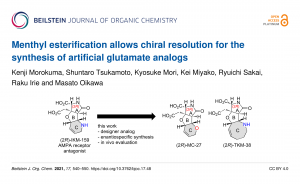Title: Menthyl esterification allows chiral resolution for the synthesis of artificial glutamate analogs
URL: https://doi.org/10.3762/bjoc.17.48

Excitatory synaptic neurotransmission in the mammalian central nervous system is mediated largely by ionotropic glutamate receptors (iGluRs). We have previously developed artificial glutamate analog (2R)-IKM-159 as a subtype-selective antagonist for the AMPA-type iGluR, by enantioselective synthesis employing chiral auxiliary strategy over 18 steps.
In this paper, we report an improved, shorter-step enantioselective synthesis and some structure-activity relationships (SAR) of IKM-159 analogs bearing six-membered oxacycle and eight-membered azacycle for the C-ring. The synthesis features chiral resolution of the carboxylic acid intermediate by esterification with L-menthol, followed by configurational analysis by NMR, conformational calculation, and X-ray crystallography. Starting from readily available oxanorbornene, optically pure (2R)-MC-27, (2R)-TKM-38, and the antipodes were enantiospecifically synthesized in total 8 steps for each.
Mice in vivo assay showed that (2R)-MC-27 with six-membered oxacycle is neuroactive, whereas the (2S)-counterpart is inactive. It was also found that the TKM-38 with eight-membered azacycle is neuronally inactive to suggest the possibility that the analog with a smaller five-membered azacycle may act as a potent agent.
The SAR data collected in this study are thus useful 1) for understanding the novel interactions between our ligands and the iGluR, and 2) for molecular design of the next generation ligand with high potency.


